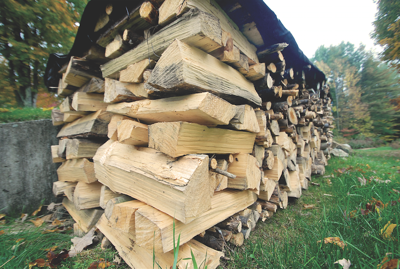“Looking for dry firewood.” “Firewood recommendations?” “Seeking firewood source.” “Looking for fireplace wood.” “Seeking seasoned firewood.” “Seasoned/dry firewood needed ASAP!”
Those were some of the entreaties and pleas dotting online forums starting in late August and ratcheting up in frequency all through September.
They came as people who rely on wood to heat their homes during the winter realized it was harder than usual to find firewood this year.
Less firewood than usual is available for this coming winter because Vermonters used more of it last winter, according to Paul Frederick, a wood utilization forester with the Vermont Department of Forests, Parks and Recreation.
“A lot of people ran out of wood toward the end of March and beginning of April, and they bought up whatever was around,” Frederick said. “So they started off in a hole, and inventory was down during the summer.”
Andy Naylor has been cutting, drying and selling firewood for almost 20 years in Johnson — his primary source of income is maple syrup — and in most years he sells 250 cords of dry wood. A typical “cord of wood” is 85 cubic feet, or a stack measuring 4 feet wide and tall and 8 feet long.
This year he was able to dry only 200 cords, and to make up for the lack of wood, he had to set his prices a bit higher this year, about $50 more per cord. And he still figures he’ll run out by the end of the month; typically he sells his last cord in mid-January.
“Firewood’s a hot commodity,” Naylor said this week.
Consumers catch up
Martha Turek had posted on Front Porch Forum in early September that she was looking for dry firewood. The forum is one of a dozen in Stowe and neighboring towns.
She said in an email last week she was able to get a load delivered the second week in September, but had to pay a hefty delivery fee.
Said Turek, “My motto for next year’s wood pile is to ‘plan ahead!’”
Elizabeth Soper, a Stowe resident also posting to Front Porch Forum, had to play catch-up when her usual firewood supplier got sick and was unable to provide wood, which she didn’t realize until August.
In an email, she said that, when she started calling around, she realized there was a lack of dry wood; everyone she contacted was either already overwhelmed with orders or didn’t have any wood left.
She found a supplier in Franklin County, Gregg Campbell, who was able to deliver two cords of dry wood, which she deemed excellent quality.
“Needless to say, I think I passed on Gregg’s name to about eight people,” Soper said.
Competing for wood
There are other wood industries competing for the logs that come out of Vermont forests, Frederick said.
The paper industry uses the same kind of wood for pulp that people use to heat their homes. And as pellet stoves, both small and industrial-scale, become more common, those pebble-sized compact pieces of wood can cut into the firewood supply, too, Frederick said.
Naylor agrees, and said loggers like the consistency of income from industry buyers more than the smaller firewood customers.
“The loggers like it because they get their checks on time,” he said.
Frederic said lumber mills are also paying more for wood, which further causes loggers to turn their eyes away from firewood sales.
“Since the economic downturn, the market for saw logs has been down, demand for lumber was down, and prices suffered to some extent,” Frederick said. “With things coming back around now, we’re getting increased demand.”
About green wood
People can still find firewood at this point in the year, Frederick said. It probably won’t be dry, but rather green wood, timber with a high water content that puts out more smoke than heat.
He said it is unwise to burn it, because it can cause creosote that increases the danger of chimney fires.
He has a few tips for stacking and drying green wood, even in October and November.
• Stack it in the sunshine, as much as you can get, and stack it perpendicular to the normal breeze direction,
• Keep it in skinny, individual rows, one piece wide, with space between the stacks to let the air flow through.
• Cover the stacks with something that keeps rain off, but doesn’t trap moisture in. The tried and true way of putting old roofing metal on top of the stacks works just fine.
















(0) comments
Welcome to the discussion.
Log In
Keep it clean. Please avoid obscene, vulgar, lewd, racist or sexual language.
PLEASE TURN OFF YOUR CAPS LOCK.
Don't threaten. Threats of harming another person will not be tolerated.
Be truthful. Don't knowingly lie about anyone or anything.
Be nice. No racism, sexism or any sort of -ism that is degrading to another person.
Be proactive. Use the "Report" link on each comment to let us know of abusive posts.
Share with us. We'd love to hear eyewitness accounts, the history behind an article.